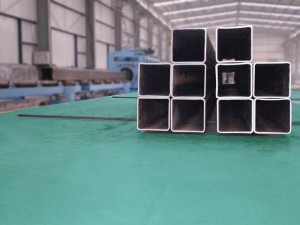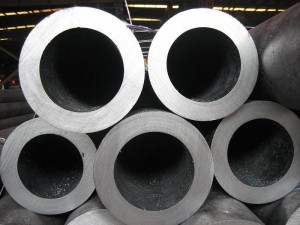Large diameter stainless steel manufacturer sales
Stainless steel pipe is a kind of hollow long round steel, which is widely used in industrial transmission pipelines such as petroleum, chemical industry, medical treatment, food, light industry, mechanical instruments and mechanical structural components. In addition, when the bending and torsional strength are the same, the weight is light, so it is also widely used in the manufacture of mechanical parts and engineering structures. It is also commonly used as furniture, kitchenware, etc.
Brinell, Rockwell and Vickers hardness indexes are commonly used to measure the hardness of stainless steel pipes.
Brinell hardness is the most widely used standard for stainless steel pipe. Indentation diameter is often used to express the hardness of the material, which is intuitive and convenient. However, it is not applicable to steel pipes with hard or thin steel.
The Rockwell hardness test of stainless steel pipe is the same as the Brinell hardness test, which is an indentation test method. The difference is that it measures the depth of the indentation. Rockwell hardness test is a widely used method, in which HRC is second only to Brinell hardness Hb in steel pipe standards. Rockwell hardness can be used to measure metal materials from very soft to very hard. It makes up for the disadvantage of Brinell method. It is simpler than Brinell method and can directly read the hardness value from the dial of hardness machine. However, because of its small indentation, the hardness value is not as accurate as Brinell method.
The Vickers hardness test of stainless steel pipe is also an indentation test method, which can be used to determine the hardness of very thin metal materials and surface layers. It has the main advantages of Brinell and Rockwell methods and overcomes their basic shortcomings, but it is not as simple as Rockwell method. Vickers method is rarely used in steel pipe standards.
W-b75 Vickers hardness tester can be used for annealed stainless steel pipes with an inner diameter of more than 6.0mm and a wall thickness of less than 13mm. It is very fast and simple, and is suitable for rapid and nondestructive qualification inspection of stainless steel pipes. For stainless steel pipes with inner diameter greater than 30mm and wall thickness greater than 1.2mm, Rockwell hardness tester shall be used to test HRB and HRC hardness. For stainless steel pipes with inner diameter greater than 30mm and wall thickness less than 1.2mm, the surface Rockwell hardness tester shall be used to test HRT or hrn hardness. For stainless steel pipes with inner diameter less than 0mm and greater than 4.8mm, use special Rockwell hardness tester for pipes to test hr15t hardness. When the inner diameter of stainless steel pipe is greater than 26mm, Rockwell or surface Rockwell hardness tester can also be used to test the hardness of the inner wall of the pipe.
Stainless steel pipes are divided into ordinary carbon steel pipes, high-quality carbon structural steel pipes, alloy structural pipes, alloy steel pipes, bearing steel pipes, stainless steel pipes, bimetallic composite pipes, coated and coated pipes to save precious metals and meet special requirements. Stainless steel pipes have a wide variety, different uses, different technical requirements and different production methods. At present, the outer diameter range of steel pipes is 0.1-4500mm and the wall thickness range is 0.01-250mm. In order to distinguish its characteristics, steel pipes are usually classified according to the following methods.
Stainless steel pipe can be divided into seamless pipe and welded pipe according to the production mode. Seamless steel pipe can be divided into hot-rolled pipe, cold-rolled pipe, cold drawn pipe and extruded pipe. Cold drawing and cold rolling are the secondary processing of steel pipe; Welded pipe is divided into straight seam welded pipe and spiral welded pipe.
Stainless steel pipe can be divided into round pipe and special-shaped pipe according to the cross-sectional shape. Special shaped tubes include rectangular tubes, rhombic tubes, elliptical tubes, hexagonal tubes, octagonal tubes and various cross-section asymmetric tubes. Special shaped pipe is widely used in various structural parts, tools and mechanical parts. Compared with circular pipe, special-shaped pipe generally has large moment of inertia and section modulus, and has large bending and torsion resistance, which can greatly reduce the structural weight and save steel.
Stainless steel pipe can be divided into equal section pipe and variable section pipe according to the profile shape. Variable section pipes include conical pipes, stepped pipes and periodic section pipes.
Stainless steel pipe can be divided into smooth pipe and threaded pipe (threaded steel pipe) according to the state of pipe end. Threading pipe can also be divided into ordinary threading pipe (pipe for conveying low pressure such as water and gas, which is connected by ordinary cylindrical or conical pipe thread) and special threaded pipe (pipe for petroleum and geological drilling, which is connected by special thread for important threading pipe). For some special pipes, in order to make up for the impact of thread on the strength of pipe end, pipe end thickening (internal thickening External thickening or internal and external thickening).
According to the purpose, it can be divided into oil well pipe (casing, oil pipe and drill pipe), pipeline pipe, boiler pipe, mechanical structure pipe, hydraulic prop pipe, gas cylinder pipe, geological pipe, chemical pipe (high-pressure fertilizer pipe, petroleum cracking pipe) and marine pipe.
Raw materials -- strip splitting -- welded pipe making -- end repair -- polishing -- Inspection (spray printing) -- Packaging -- delivery (warehousing) (decorative welded pipe).
Raw materials -- strip splitting -- welded pipe making -- heat treatment -- Correction -- straightening -- end repair -- pickling -- Hydrostatic Test -- Inspection (spray printing) - packaging -- delivery (warehousing) (pipes for welded pipe industrial piping).








